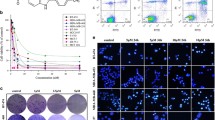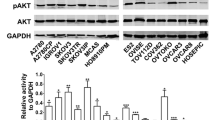Summary
EGFR overexpression in gynecologic cancer has been associated with poor prognosis. Targeted inhibition of EGFR via its tyrosine kinase domain is a successful treatment in lung cancer. However, the results of existing clinical trials in gynecologic cancers do not show a significant clinical response to EGFR inhibition alone in unscreened patients. Novel EGFR-TKI might be beneficial for patients with gynecologic cancers. In this article, the in vitro and in vivo effects of a newly synthesized novel EGFR tyrosine kinase inhibitor N-(3-bromophenyl)-N-(7-methoxy-6-(3-morpholinopropoxy)quinazolin-4-yl)-3,3-dimethylbutanamide (F84) is being reported. In vitro, F84 and PD153035 significantly inhibited the growth of four different human gynecologic cancer cell lines in a dose-dependent manner. In vivo, F84 exhibited an inhibitory effect on gynecologic malignancies. While the mechanism of action is still unclear, it might be related to inhibition of EGFR signaling pathway, delay in cell cycle progression and a G1 arrest together with a partial G2/M block and induction of apoptosis. These results suggest that F84 could be a potential drug candidate for the treatment of human gynecologic malignancies.



Similar content being viewed by others
References
Jemal A (2007) Cancer statistics, 2007. CA Cancer J Clin 57:43
McGuire WP (1996) Cyclophosphamide and cisplatin compared with paclitaxel and cisplatin in patients with stage III and IV ovarian cancer. N Engl J Med 334:1–6. doi:10.1056/NEJM199601043340101
Ashouri S, Garcia AA (2007) Current status of signal transduction modulators in the treatment of gynecologic malignancies. Curr Treat Options Oncol 8(6):383–392. doi:10.1007/s11864-007-0051-z
Bellone S, Frera G, Landolifi G (2007) Overexpression of epidermal growth factor typr-1 receptor (EGF-R1) in cervical cancer: implications for cetuximab-mediated therapy in recurrent/metastatic disease. Gynecol Oncol 106(3):513–520. doi:10.1016/j.ygyno.2007.04.028
Kim GE, Kim YB, Cho NH, Chung HC, Pyo HR, Lee JD (2004) Synchronous co-expression of epidermal growth factor receptor and cyclooxygenase-2 in carcinomas of the uterine cervix: a potential predictor of poor survival. Clin Cancer Res 10(4):1366–1374. doi:10.1158/1078-0432.CCR-0497-03
Schlessinger J (2002) Ligand-induced, receptor-mediated dimerization and activation of EGF receptor. Cell 110:669–672. doi:10.1016/S0092-8674(02)00966-2
Schlessinger J (2000) Cell signaling by receptor tyrosine kinases. Cell 103:211–225. doi:10.1016/S0092-8674(00)00114-8
Fry DW, Kraker AJ, McMichael A, Ambroso LA, Nelson JM, Leopold WR (1994) A specific inhibitor of the epidermal growth factor receptor tyrosine kinase. Science 265:1093–1095. doi:10.1126/science.8066447
Boschelli DH (2002) 4-Anilino-3-quinolinecarbonitriles: an emerging class of kinase inhibitors. Curr Top Med Chem 2(9):1051–1063
Bos M, Mendelsohn J, Kim YM, Albanell J, Fry DW, Baselga J (1997) PD153035, a tyrosine kinase inhibitor, prevents epidermal growth factor receptor activation and inhibits growth of cancer cells in a receptor number-dependent manner. Clin Cancer Res 3(11):2099–2106
Marshall J (2006) Clinical implications of the mechanism of epidermal growth factor receptor inhibitors. Cancer 107(6):1207–1218. doi:10.1002/cncr.22133
Schilder RJ, Sill MW, Chen X (2005) Phase II study of gefitinib in patients with relapsed or persistent ovarian or primary peritoneal carcinoma and evaluation of epidermal growth factor receptor mutations and immunohistochemical expression: a Gynecologic Oncology Group study. Clin Cancer Res 11:5539–5548. doi:10.1158/1078-0432.CCR-05-0462
Baselga J, Rischin D, Ranson M et al (2002) Phase I safety, pharmacokinetic and pharmacodynamic trial of ZD 1839, a selective oral epidermal growth factor receptor tyrosine kinase inhibitor, in patients with five selected tumor types. J Clin Oncol 20:4292–4302. doi:10.1200/JCO.2002.03.100
Slomovitz BM, Coleman RL, Levenback C et al (2006) Phase I study of weekly topotecan and gefitinib in patients with platinum resistant ovarian, peritoneal or fallopian tube cancer. J Clin Oncol (2006 ASCO Annual Meeting Proceedings Part I) 24(Suppl.):5090
Hariprasad R, Kumar L, Patnaik R, Gupta A, Kumar S (2006) Maintenance therapy in epithelial ovarian cancer (EOC): could EGFR inhibitor-gefitinib be a candidate drug? A pilot study. J Clin Oncol (2006 ASCO Annual Meeting Proceedings Part I) 24(Suppl.):15046
Nicholson RI, Gee JM, Harper ME (2001) EGFR and cancer prognosis. Eur J Cancer 37(suppl 4):S9–S15. doi:10.1016/S0959-8049(01)00231-3
Sewell JM, Macleod KG, Ritchie A, Smyth JF, Langdon SP (2002) Targeting the EGF receptor in ovarian cancer with the tyrosine kinase inhibitor ZD1839 (“Iressa”). Br J Cancer 86(3):456–462. doi:10.1038/sj.bjc.6600058
Vermeij J, Teugels E, Bourgain C, Xiangming J, in’t Veld P, Ghislain V, Neyns B, De Grève J (2008) Genomic activation of the EGFR and HER2-neu genes in a significant proportion of invasive epithelial ovarian cancers. BMC Cancer 8:3
Lacroix L, Pautier P, Duvillard P, Motte N, Saulnier P, Bidart JM, Soria JC (2006) Response of ovarian carcinomas to gefitinib–carboplatin–paclitaxel combination is not associated with EGFR kinase domain somatic mutations. Int J Cancer 118(4):1068–1069. doi:10.1002/ijc.21460
Rivera F, Vega-Villegas ME, López-Brea MF (2008) Cetuximab, its clinical use and future perspectives. Anticancer Drugs 19(2):99–113
Palayekar MJ, Herzog TJ (2008) The emerging role of epidermal growth factor receptor inhibitors in ovarian cancer. Int J Gynecol Cancer 8(5):879–890. doi:10.1111/j.1525-1438.2007.01144.x
Woodburn JR (1999) The epidermal growth factor receptor and its inhibition in cancer therapy. Pharmacol Ther 82:241–250. doi:10.1016/S0163-7258(98)00045-X
Ciardiello F, Tortora G (2001) A novel approach in the treatment of cancer: targeting the epidermal growth factor receptor. Clin Cancer Res 7:2958–2970
Acknowledgments
We thank Dr. Manjari Dimri for help in revising the manuscript.
Author information
Authors and Affiliations
Corresponding author
Rights and permissions
About this article
Cite this article
Li, J., Meng, Y., Liu, Y. et al. F84, a quinazoline derivative, exhibits high potent antitumor activity against human gynecologic malignancies. Invest New Drugs 28, 132–138 (2010). https://doi.org/10.1007/s10637-009-9225-9
Received:
Accepted:
Published:
Issue Date:
DOI: https://doi.org/10.1007/s10637-009-9225-9




